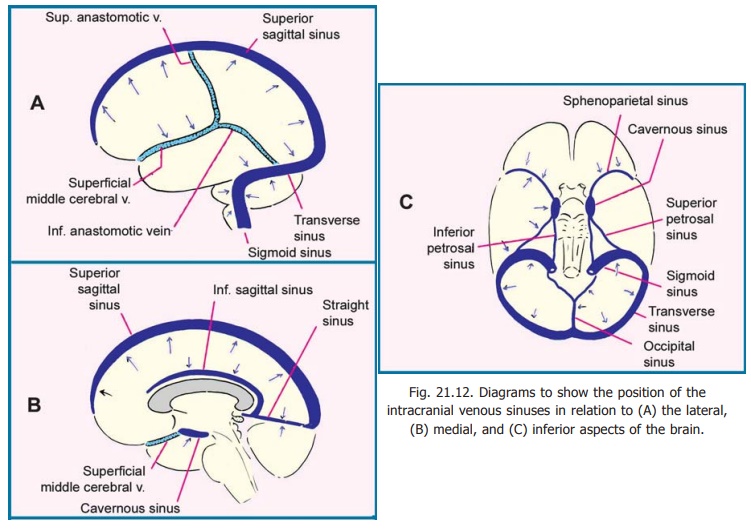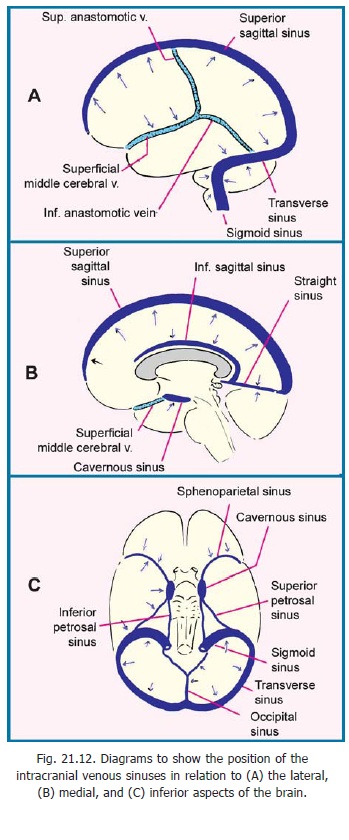Chapter: Human Neuroanatomy(Fundamental and Clinical): Blood Supply of Central Nervous System
Venous Drainage of the Brain - Blood Supply of Central Nervous System

Venous Drainage of the Brain
The veins draining the brain open into the dural venous sinuses (Fig. 21.12). These are the superior sagittal, inferior sagittal, straight, transverse, sigmoid, cavernous, sphenoparietal, petrosal and occipital sinuses. Ultimately, the blood from all these sinuses reaches the sigmoid sinus which becomes continuous with the internal jugular vein. The intracranial venous sinuses communicate with veins outside the skull through emissary veins. For details about intracranial venous sinuses see the author’s Textbook of Anatomy.
The venous drainage of individual parts of the brain is described below.

Veins of the Cerebral Hemisphere
The veins of the cerebral hemisphere consist of two sets, superficial and deep.
The superficial veins drain into neighbouring venous sinuses. The superior cerebral veins drain the upper parts of the superolateral and medial surfaces, and end in the superior sagittal sinus. Some veins from the medial surface join the inferior sagittal sinus. Inferior cerebral veins drain the lower part of the hemisphere. On the superolateral surface, they drain into the superficial middlecerebral vein which lies superficially along the lateral sulcus and its posterior ramus. The posteriorend of this vein is connected to the superior sagittal sinus by the superior anastomotic vein; and to the transverse sinus by theinferior anastomotic vein. The superficial middle cerebral vein terminates in the cavernous sinus. Veins from the inferior surface of the cerebral hemisphere drain into the transverse, superior petrosal, cavernous and sphenoparietal sinuses. Some may ascend to join the inferior sagittal sinus.

The deep veins of the cerebral hemisphere are the two internal cerebral veins, that join to form the great cerebral vein (Fig. 21.13); and the two basal veins, that wind round the midbrain to end in the great cerebral vein. Each internal cerebral vein begins at the interventricular foramen, andruns backwards in the tela choroidea, in the roof of the third ventricle. It has numerous tributaries. One of these is thethalamostriate vein which lies in the floorof the lateral ventricle (between the thalamus, medially; and the caudate nucleus, laterally). Each basal vein begins near the anterior perforated substance. It is formed by union of the following.
(a) The anterior cerebral vein, which accompanies the anterior cerebral artery.
(b) The deep middle cerebral vein, which lies deep in the stem and posterior ramus of the lateral sulcus.
(c) Some inferior striate veins thatemerge from the anterior perforated substance.
The great cerebral vein, formed by union of the two internal cerebral veins, passes posteriorly beneath the splenium of the corpus callosum, to end in the straight sinus. It receives the basal veins, some veins from the occipital lobes, and some from the corpus callosum.
The deep cerebral veins described above are responsible for draining the thalamus, the hypothalamus, the corpus striatum, the internal capsule, the corpus callosum, the septum pellucidum, and the choroid plexuses. Many tributaries of the internal cerebral veins extend beyond the corpus striatum into the white matter of the hemispheres. Here they establish communications with superficial veins. They can thus serve as alternative channels for draining parts of the cerebral cortex.
The upper part of the thalamus is drained by the tributaries of the internal cerebral vein (including the thalamostriate vein). The lower part of the thalamus, and the hypothalamus, are drained by veins that run downwards to end in a plexus of veins present in the interpeduncular fossa. This plexus drains into the cavernous and sphenoparietal sinuses, and into the basal veins.
The corpus striatum and internal capsule are drained by two sets of striate veins. The superiorstriate veins run dorsally and drain into tributaries of the internal cerebral vein. The inferior striate veinsrun vertically downwards and emerge on the base of the brain through the anteriorperforated substance. Here they end in the basal vein.
Veins of the cerebellum and brainstem
The veins from the upper surface of the cerebellum drain into the straight, transverse, and superior petrosal venous sinuses. Veins from the inferior surface drain into the right and left sigmoid, and inferior petrosal, sinuses; the occipital sinus and the straight sinus.
The veins of the midbrain drain into the great cerebral vein or into the basal vein. The pons and medulla drain into the superior and inferior petrosal sinuses, the transverse sinus and the occipitalsinus. Inferiorly, the veins of the medulla are continuous with the veins of the spinal cord.
Related Topics